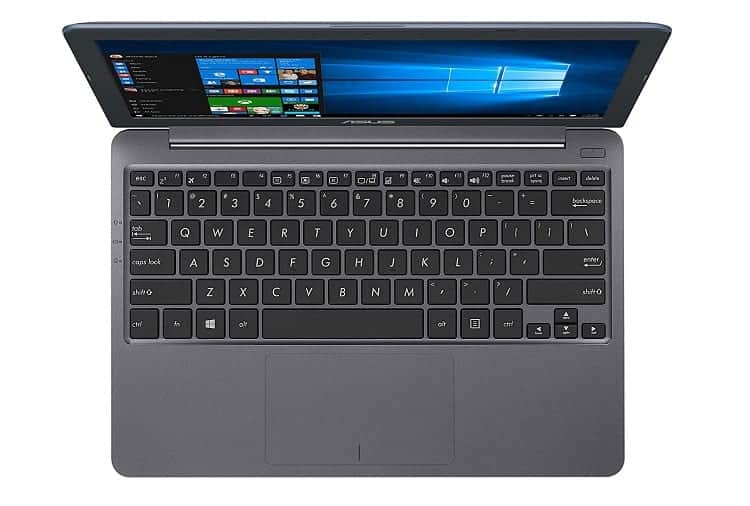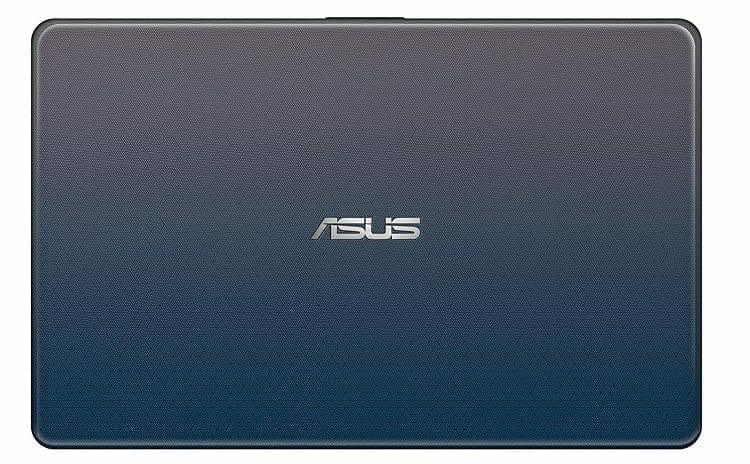With the Asus VivoBook E203NA-YS03, the company delivers a budget netbook in the 11.6-inch format. It is powered by a dual-core Celeron (Apollo Lake generation), which is the same chip used in its predecessor, the Asus VivoBook E200HA-UB02-GD. While it’s a value buy and looks nice, it fails to impress on anything else. Battery life is short, display lackluster and the Intel Celeron processor provides middling performance. Obviously, you can’t expect premium performance at this price range, but competing notebooks like the Lenovo IdeaPad 120S offer better experience than this.
Design
The VivoBook E203NA is a budget laptop, and it feels like one. However, on the outside it looks better than most sub-$300 notebooks we see around. The star-gray lid has a subtle honeycomb pattern with a silver Asus logo in the center. This Vivobook’s case is entirely made of plastic, which is not surprising at all. Still, the build quality is very convincing, a you don’t have gaps or sharp edges on the exterior.
If you’re concerned of a case that picks fingerprints randomly, this one is the real magnet. Either way, you’ll have to wipe it constantly, or else the glossy finish will mimic a crime scene. Once you flip it open, there’s an 11.6-inch display surrounded by a thick, boring bezel set on a gray plastic deck.
Even with the thin profile, this netbook manages to offer good connectivity. There are three USB ports (2 x USB 3.1 Gen 1; USB-C 3.1 Gen 1), and an HDMI port as the only video output. Others include Headphone/microphone combo jack and a microSD card reader. It utilizes a Wi-Fi chip that supports the fast 802.11ac and Bluetooth 4.1 protocol.
It weighs 2.2 pounds and measures 0.7 inches thick, which is slightly lighter than competitors. For instance, the Lenovo Ideapad 120S is the same 0.7 inches thick and weighs 2.4 pounds, while the 14-inch HP Stream is fairly heavier at 3.1 pounds, but the same 0.7 inches thick.
Display
When buying a budget laptop, there are features that you’ll have to compromise to do with and, display is always the culprit. That’s not exceptional here. The VivoBook’s 11.6-inch display has a max resolution of 1366-by-768, which is dim and dull. When watching the trailer for Black Panther, scenes from the Wakandans’ vibranium are barely visible, as it flies over the kingdom, all you see is a blue-dark moving object.
This display covers just 45 percent of the sRGB color gamut, lower than the Lenovo Ideapad 120S (64 percent), with the HP Stream (82 percent) being more vivid. Still, all of them fall below the standard average for budget laptops (91 percent). Also, there’s a 640-by-480 camera, which is nothing short of a joke with dark and almost colorless visuals.
Keyboard and Touchpad
On this Vivobook is a surprisingly deep keyboard, with 1.7 millimeters of travel that require only 68 grams to press the keys. While that’s impressive, the keys are cut out of cheap plastic and the11.6-inch body doesn’t leave enough room to rest both your hands. If you’re a pro-typer, you can easily hit 112 words per minute, of course with a few errors in between.
The touchpad measures 4.1 by 2.4 inches and seamlessly accommodates Windows 10 S gestures that comes pre-installed with the system. It lets you swipe apps with three fingers, tap four fingers to open the Action Center, though it feels a little cheap and flimsy. More importantly, it gets the job done.
 Performance
Performance
When buying the Asus E203NA-YS03, you must be aware that you aren’t buying the most powerful netbook around. Powering it is a passively cooled dual-core Intel Celeron N3350 (Apollo Lake) processor with a base speed of 1.1GHz, but can be boosted to a maximum of 2.3GHz on both cores. This processor alongside 4GB of RAM, 64GB of flash memory and Intel HD 500 graphics card are only sufficient for simple office and web applications.
It is one of those systems that can run smoothly for as long as you keep your tasks simple. You can possibly have 5-6 Google Chrome tabs open, with one streaming a 1080p clip, but will lag once you push the open tabs to, maybe eight. Data transfers are also on the slower side, at 26.9MBps, against the budget-notebook average of 40.9 MBps, with the Lenovo Ideapad being the best in the category at 38.7 MBps.
While the 64GB of eMMC doesn’t offer much in terms of storage, it’s still a better choice than the 32GB on most laptops, plus it can be complemented via an external hard drive on an SD card. Out-of-the-box, around 38.7GB is available to the user, but after uninstalling the included software, free space rises to 46.9GB since the included Windows 10 S requires around 10GB to store regular updates.
Battery Life
If your laptop requirements are in a way that you need to be powered throughout the day, maybe a day in school or work, remember to carry along the charger. This VivoBook won’t last all day on a single charge. The much you’re getting is around 6 hours 27 minutes (running Windows 10 S) which is the much I got with continuous browsing the web and watching videos at full brightness.
With Windows 10 Pro installed, you might be lucky with few more minutes. Either way, it’s below the category average of 7 hours 18 minutes; of which the HP Stream (7: 09) and Lenovo IdeaPad 120S (8:40) are among the best performers.
Bottom Line
The ASUS VivoBook E203NA-YS03 is a budget laptop, with good aesthetics, nice build quality, but doesn’t offer anything much to stand out of the crowd. I have issue with the display that looks both dull and dim, in addition to the short battery life and a webcam that’s worse as it can go. If you need something more practical in this price range, your best bet might be the Lenovo Ideapad 120S. The 11.6-inch display isn’t that cramped together and it least it’s bright. It also offers better performance, and its battery lasts about 2 hours more.

